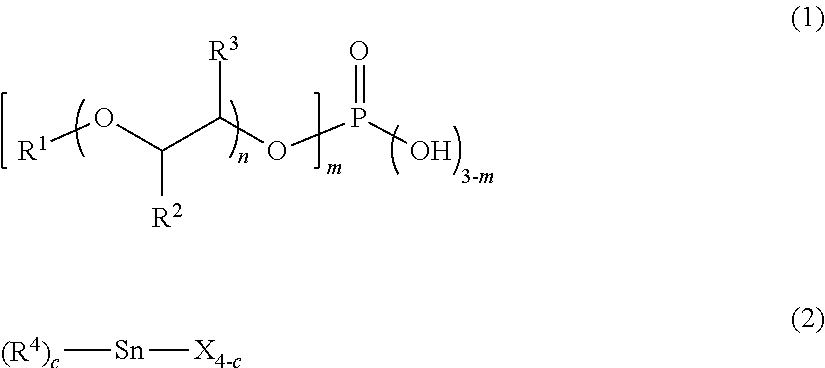Polymerizable composition for optical material, optical material produced from same, and process for producing same
a technology of polymerizable composition and optical material, which is applied in the field of polymerizable composition for optical material, optical material produced from same, and process for producing same, can solve the problems of reducing product yield, unable to stably obtain polymerizable composition, and tended to be inferior in impact resistance, etc., and achieves excellent heat resistance, excellent transparency, and high refractive index.
- Summary
- Abstract
- Description
- Claims
- Application Information
AI Technical Summary
Benefits of technology
Problems solved by technology
Method used
Image
Examples
first embodiment
[0139]The production method of the present embodiment includes the following steps.
[0140]Step a1: The isocyanates (A) and the tin compound (D) are mixed in the presence of 32 parts by weight or more of the acidic phosphoric acid ester (C) with respect to 100 parts by weight of tin contained in the tin compound (D).
[0141]Step a2: Subsequently, the resulting mixture was mixed with the acidic phosphoric acid ester (C) if desired, and the thiols (B).
[0142]The production method of the present embodiment is to mix the isocyanates (A) and the tin compound (D) in the presence of a predetermined amount of the acidic phosphoric acid ester (C). In this manner, the modification of isophorone diisocyanate is inhibited, whereby the generation of a gel-like substance can be inhibited. The generation of a gel-like substance is confirmed by checking the presence or absence thereof by visual inspection.
[0143]Since there may a case where a gel-like substance is generated in the mixed liquid when the t...
second embodiment
[0159]The production method of the present embodiment includes the following steps.
[0160]Step b1: The thiols (B) and the tin compound (D) are mixed.
[0161]Step b2: Subsequently, the resulting mixture is mixed with the isocyanates (A), and the acidic phosphoric acid ester (C).
[0162]The generation of a gel-like substance can be inhibited by the production in this addition order.
[0163](Step b1)
[0164]Specifically, in step b1, the thiols (B) and the tin compound (D) are mixed. In step b1, the acidic phosphoric acid ester (C) added in step b2 may be added without particular limitation.
[0165]Since the tin compound (D) or the acidic phosphoric acid ester (C) is of a small amount as compared to other components, there may be a case where weighing and uniform dissolution of the tin compound (D) or the acidic phosphoric acid ester (C) become difficult when mixing and dissolving with other components. Moreover, a master solution containing the tin compound (D) at a high concentration can be used...
third embodiment
[0171]The production method of the present embodiment includes the following steps.
[0172]Step c1: The isocyanates (A) and the thiols (B) are mixed.
[0173]Step c2: Subsequently, the acidic phosphoric acid ester (C) and the tin compound (D) are added to the resulting mixture, followed by mixing.
[0174]The generation of a gel-like substance can be inhibited by the production in this addition order.
[0175]The mixing method in step c1 is not particularly limited, and a mixing device, rotational speed, an addition method, an addition rate and mixing time are appropriately selected depending on the volume of a mixed solution to achieve homogeneous mixing. The temperature during the mixing is not particularly limited, but it is preferably 10° C. to 25° C. Further, the mixing is preferably carried out in the presence of an inert gas, for example, in the presence of a nitrogen or argon gas.
[0176]In step c2, a polymerizable composition for an optical material can be obtained by adding the acidic ...
PUM
| Property | Measurement | Unit |
|---|---|---|
| specific gravity | aaaaa | aaaaa |
| height | aaaaa | aaaaa |
| temperature | aaaaa | aaaaa |
Abstract
Description
Claims
Application Information
 Login to View More
Login to View More - R&D
- Intellectual Property
- Life Sciences
- Materials
- Tech Scout
- Unparalleled Data Quality
- Higher Quality Content
- 60% Fewer Hallucinations
Browse by: Latest US Patents, China's latest patents, Technical Efficacy Thesaurus, Application Domain, Technology Topic, Popular Technical Reports.
© 2025 PatSnap. All rights reserved.Legal|Privacy policy|Modern Slavery Act Transparency Statement|Sitemap|About US| Contact US: help@patsnap.com



